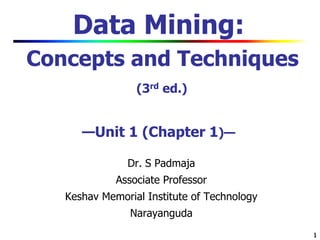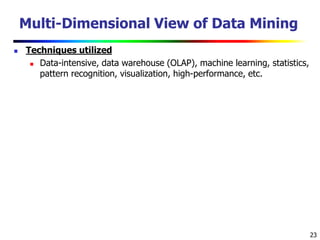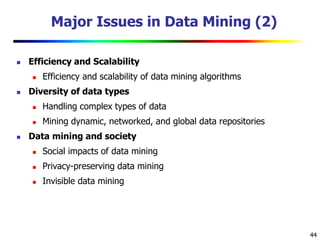This document provides an introduction to data mining concepts. It discusses why data mining is important due to the massive growth of data. It defines data mining as the automated analysis of large datasets to discover hidden patterns and unknown correlations. The document presents a multi-dimensional view of data mining, including the types of data that can be mined, the patterns that can be discovered, techniques used, and applications. It provides an overview of the key concepts in data mining.




















![21
Data Mining Functionalities
Multidimensional concept description: Characterization and
discrimination
Generalize, summarize, and contrast data characteristics, e.g.,
dry vs. wet regions
Frequent patterns, association, correlation vs. causality
Diaper Beer [0.5%, 75%] (Correlation or causality?)
Classification and prediction
Construct models (functions) that describe and distinguish
classes or concepts for future prediction
E.g., classify countries based on (climate), or classify cars
based on (gas mileage)
Predict some unknown or missing numerical values](https://image.slidesharecdn.com/unit1chapter-1-240121163727-3ca6ce46/85/Unit-1-Chapter-1-on-data-mining-concepts-ppt-21-320.jpg)






![28
Data Mining Function: (2) Association and
Correlation Analysis
Frequent patterns (or frequent itemsets)
What items are frequently purchased together in your
Walmart?
Association, correlation vs. causality
A typical association rule
Diaper Beer [0.5%, 75%] (support, confidence)
Are strongly associated items also strongly correlated?
How to mine such patterns and rules efficiently in large
datasets?
How to use such patterns for classification, clustering,
and other applications?](https://image.slidesharecdn.com/unit1chapter-1-240121163727-3ca6ce46/85/Unit-1-Chapter-1-on-data-mining-concepts-ppt-28-320.jpg)






















